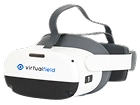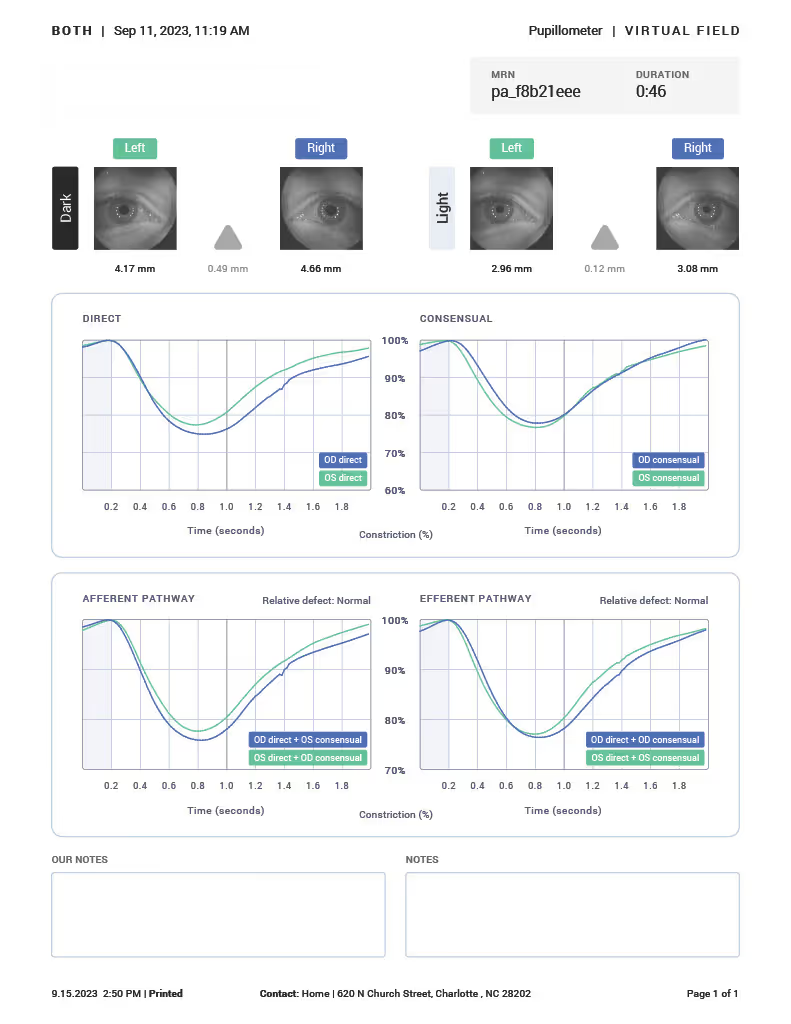Pupil reaction can be revealing. An automated pupillometry exam using a digital pupillometer device provides critical insight for patients with neurological conditions, injuries, or optic neuropathies. With Virtual Field’s advanced tools, you can perform a portable pupil light reflex exam and assess the health of the optic nerve, brainstem, and autonomic nervous system in seconds. In seconds, you can gain non-invasive insight into your patient’s neurological health and identify health issues ranging from manageable conditions to medical emergencies.
The automated pupillometry exam becomes even more efficient when performed with Virtual Field. Learn how you can make the most of the pupillometry exam with Virtual Field and gain the most accurate insights possible.
Pupillometry Test Overview
The automated pupillometry exam is designed to measure the patient’s pupillary reaction to light in a highly controlled, objective manner using a digital pupillometer device. Virtual Field’s VF3 Pro headset includes a virtual field pupil test setting for consistent and reproducible results.
Through this exam, an automated pupillometer emits a pulse of light, then records the pupil’s response to the stimulus. It measures pupil size, the pupil light reflex, energy of the pupil movement, relative apparent pupillary defects, and other key details. The test duration can vary depending on your tools, the patient’s cooperation, and pupil response.
Pupillometry is used in both ophthalmology practices and in critical care settings. Traditional manual pupillary assessment using a flashlight may provide some insight, but it’s not quantifiable and is highly subjective. With a specialized pupillometry exam, you can observe and measure the pupil’s response. This way, you can diagnose and treat neurological conditions with better accuracy.
Using traditional pupillometers can require a long setup process to achieve proper fixation. It can also be an expensive investment if you only conduct this test occasionally. Virtual Field is a much more affordable choice for ophthalmology and optometry practices. This virtual reality headset is comfortable for patients to wear, and it automatically adjusts to provide the most precise data possible so you can make faster and more accurate clinical decisions.
For clinics exploring options to buy an infrared pupillometer alternative, Virtual Field offers a seamless solution with EHR integration, low overhead, and clinical-grade accuracy.
Academic references and clinical validation
As adoption of digital pupillometer devices grows in neurology and ophthalmology, studies continue to validate their value for early detection of neurological disorders.
Research shows that the pupillary light reflex is especially helpful in assessing patients with TBI and helping drive better outcomes.
Pupillometry can even provide insight into general neurological behavior. This study found that pupillometry is a reliable and time-sensitive measure for sustained attention.
Our customers realize an average of 902% return on investment with Virtual Field.
.avif)
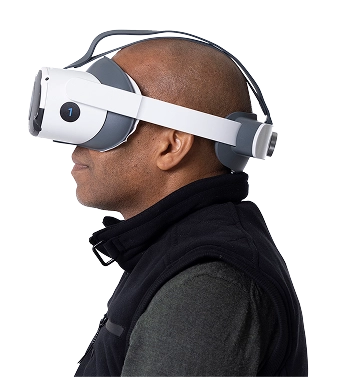
30 days free.
No strings attached.
We are confident you’ll love Virtual Field just like the 2,000 doctors who have already made the switch.
The Pupillometry Exam at a Glance
In its simplest form, an automated pupillometry exam measures the pupil’s response to light stimulation using a portable pupil light reflex system. These digital tools replace subjective flashlight exams with reliable, reproducible data.
Historically, this was done with a flashlight, but today, automated pupillometer exams collect a detailed and objective analysis of the pupil’s responses. It’s non-invasive, but highly sensitive and can detect subtle abnormalities in the autonomic nervous system, optic nerve, and brainstem — even before symptoms become apparent. It’s extremely useful, but it is limited. Pupillometry doesn’t provide insight into visual field changes, visual acuity, or any non-neurological conditions.
Pros and cons of Automated Pupillometry
The pros and cons that follow can help guide you toward the ideal scenarios to incorporate this test into your patients' diagnostic assessments.
Pros
Collect objective data with precise, quantifiable measurements of pupil reactions.
Pupillometry is sensitive to subtle changes in the nervous system’s pathways. This factor helps support early detection of neurological and autonomic disorders.
Neurological health is traditionally challenging to analyze, but this non-invasive test is a simple way to glean information and make quick assessments.
The simplest pupillometry exams take only seconds to conduct.
Cons
Pupillometry is limited in scope. This test does not provide information about macular diseases, peripheral visual field defects, or non-neurological conditions.
Patient cooperation may be a challenge, especially using traditional pupillometers with younger patients and those who are easily distressed or fatigued.
Patients’ medications, anxiety, or natural pupil differences can interfere with results.
Using old-fashioned methods will not provide detailed information, and specialized pupillometers can be expensive.
List of Ocular Diseases Monitored and Diagnoses Identified by Pupillometry Testing
Optic Neuropathy
The pupil’s response can indicate early optic nerve dysfunction. Conditions like ischemic optic neuropathy or optic neuritis can cause abnormal pupil reactions that are detectable with pupillometry.
Autonomic Dysfunction
Autonomic dysfunction conditions affect involuntary physiological responses, including the pupil’s reflexes. Pupillometry detects these early signs, that might otherwise go unnoticed in a routine exam.
Horner’s Syndrome
Horner’s syndrome is a rare condition that disrupts sympathetic nerve pathways, causing abnormal pupil constriction and eyelid drooping, which you can identify using precise pupillometry.

2.8M
About 2.8 million Americans sustain a TBI each year.
50%
More than 50% of people with TBI experience some form of visual dysfunction.
Traumatic Brain Injury (TBI)
TBI can disrupt neurological pathways that control pupil reactions. Pupillometry is highly sensitive to these changes, so with quantifiable data, you can assess the severity of the injury, track recovery, and better predict outcomes.
Multiple Sclerosis (MS)
MS can damage nerve fibers and cause optic neuritis, which often presents with abnormal pupillary responses. Pupillometry helps track changes in the pupil’s reactivity as part of monitoring disease progression.
Adie’s Pupil
Another uncommon condition, Adie’s pupil is characterized by pupils that are unequal in size or don’t respond normally to light. Pupillometry can measure the parasympathetic nerve damage and help achieve this diagnosis.
Other Conditions
Pupillometry can also be used to monitor or diagnose:
- Migraine-related pupillary changes
- Parkinson’s disease
- Brainstem lesions
- Alzheimer’s disease
- Stroke
Example Pupillometry Report
30 days free.
No strings attached.
We are confident you’ll love Virtual Field just like the 2,000 doctors who have already made the switch.
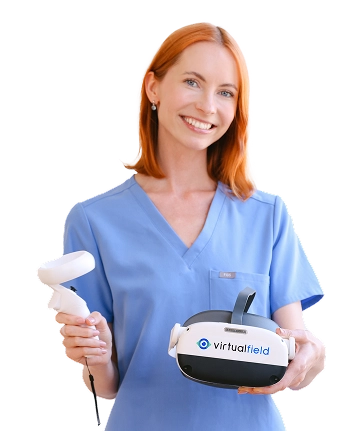
Pupillometer Device for Ophthalmology Price:
What to Expect
When evaluating your pupillometer device for ophthalmology, price options can vary widely depending on the technology, features, and clinical needs. At the most basic level, a manual flashlight test used for Pupillary Light Reflex assessments is inexpensive but lacks objectivity, quantifiable data, and recorded documentation.
On the higher end, dedicated handheld or desktop pupillometer devices may offer more advanced analytics but often come with a high upfront cost — sometimes reaching several thousand dollars — requiring a significant upfront investment and ongoing maintenance costs.
Virtual Field's VF3 Pro offers an accessible alternative: a virtual reality-based device that features pupillometry within a comprehensive vision testing suite. This solution is available through an affordable monthly subscription model, significantly lowering the barrier to entry for ophthalmology and optometry practices that want to add automated pupillometry to their diagnostic toolkit without a significant capital investment.
Billing and Coding for Pupillometry
The updated CPT code for pupillometry is 95919. This code is used specifically for automated quantitative pupillometry exams and you must interpret both unilateral and bilateral results. With Virtual Field, this data is instantly uploaded to your EHR to help expedite interpretation, treatment, and billing.
The Medicare Physician Fee Schedule (MPFS) indicates reimbursement between $6 and $20, depending on your location, setting, modifiers, and other practice factors.
When is pupillometry required?
Pupillometry is essential for patients with suspected or diagnosed neurological conditions, including traumatic brain injury, optic neuropathy, and autonomic dysfunction. It’s not usually part of routine screenings.
For patients with known neurological condition, regular monitoring and pupillometry measurements can help track progression, guide treatment decisions, and measure the effectiveness of current interventions. Pupillometry is also useful for monitoring patients with high-risk conditions, such as those recovering from brain injury or surgery.
Is pupillometry required for driver’s licenses?
No, the pupillometry exam isn’t a requirement for standard driver’s licenses or CDLs. However, for patients with neurological conditions that affect pupil response — like TBI, MS, or optic neuropathy — it’s important to assess their ability to drive safely. The pupillometry exam cannot answer that question but can help inform treatment.
Start Conducting Pupillometry Exams with Virtual Field
Monitoring pupil response has been a key diagnostic tool for centuries, and now it’s incredibly precise — thanks to automated pupillometry delivered through a virtual field pupil test. With our digital pupillometer device built into the VF3 Pro headset, you can offer a portable pupil light reflex exam at scale.
Want all 23 exam guides in one place?
Download our comprehensive guide for 160+ pages of insights.
FAQs
1. What pupil metrics does automated pupillometry report?
2. Which CPT code applies to objective pupillometry?
3. How is automated pupillometry used in concussion management?
4. Does the device detect a relative afferent pupillary defect (RAPD)?
5. How long does a pupillometry test take?
6. Are results affected by ambient light?
Ready to get started?
Schedule a demo or begin your 30-day free trial of Virtual Field to try our EOM exam in your practice.
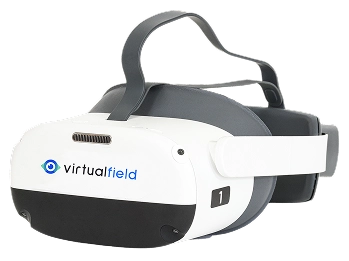
Questions? Contact sales@virtualfield.io talk to a Virtual Field expert today.

